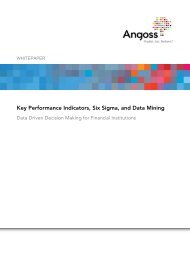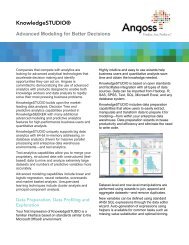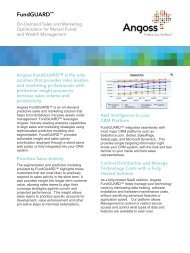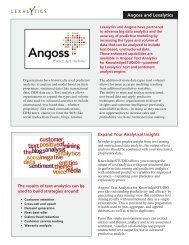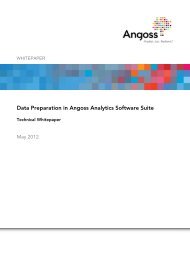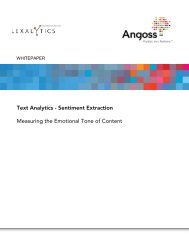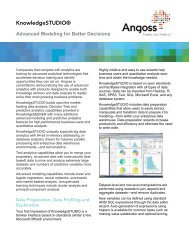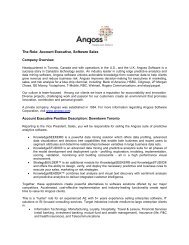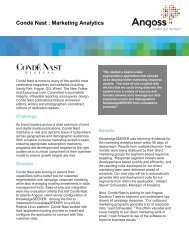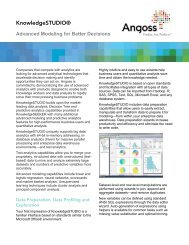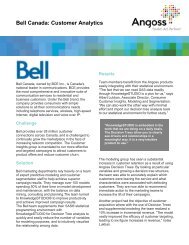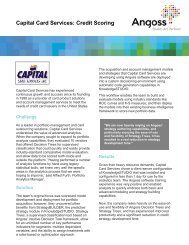Scorecards in KnowledgeSTUDIO - Angoss Software Corporation
Scorecards in KnowledgeSTUDIO - Angoss Software Corporation
Scorecards in KnowledgeSTUDIO - Angoss Software Corporation
You also want an ePaper? Increase the reach of your titles
YUMPU automatically turns print PDFs into web optimized ePapers that Google loves.
<strong>Scorecards</strong> <strong>in</strong> <strong>KnowledgeSTUDIO</strong><br />
Creat<strong>in</strong>g scorecards us<strong>in</strong>g advanced<br />
scor<strong>in</strong>g models and predictive analytics<br />
Many f<strong>in</strong>ancial services organizations make use<br />
of scorecards <strong>in</strong> order to mitigate risk and<br />
m<strong>in</strong>imize loss. Lenders and creditors need to<br />
analyze the characteristics of new applicants<br />
and exist<strong>in</strong>g customers <strong>in</strong> order to determ<strong>in</strong>e<br />
whether <strong>in</strong>dividual customers are likely to<br />
provide a profitable return on the services they<br />
receive. Collections look at the same<br />
<strong>in</strong>formation <strong>in</strong> order to determ<strong>in</strong>e the likelihood<br />
of customer default. This <strong>in</strong>creases the<br />
efficiency of collections efforts and maximizes<br />
the payments they receive from debtors.<br />
Credit scorecards help to significantly improve<br />
customer acquisition, reduce bus<strong>in</strong>ess loss and<br />
comply with regulations. <strong>Angoss</strong> enables these<br />
benefits with scorecard<strong>in</strong>g capabilities <strong>in</strong><br />
<strong>KnowledgeSTUDIO</strong>®. Behavioral and<br />
application scorecard creation—complete with<br />
reject <strong>in</strong>ference—is delivered through an easyto-use<br />
<strong>in</strong>terface us<strong>in</strong>g <strong>Angoss</strong>’ best-<strong>in</strong>-class<br />
Decision Trees and Strategy Trees.<br />
<strong>in</strong>stitution to <strong>in</strong>stitution, but is usually focused<br />
on the customer’s likelihood to default on loans,<br />
or miss a payment with<strong>in</strong> a def<strong>in</strong>ed period of<br />
time. The scorecard will score their personal<br />
<strong>in</strong>formation based on a series of predef<strong>in</strong>ed<br />
standards. Individuals are identified as “bad”<br />
customers if their score fails to meet a certa<strong>in</strong><br />
threshold.<br />
<strong>KnowledgeSTUDIO</strong> puts the power of<br />
scorecard creation <strong>in</strong> the hands of credit risk<br />
managers and credit analysts to create<br />
predictive scorecards that span the entire risk<br />
management lifecycle—from acquisition<br />
through to collections. The scorecard tool <strong>in</strong><br />
<strong>KnowledgeSTUDIO</strong> provides the user with<br />
<strong>in</strong>tuitive and easy to follow wizards that guide<br />
them through every step of scorecard<br />
development and deployment.<br />
Application <strong>Scorecards</strong><br />
Application scorecards are typically used to<br />
predict the probability that prospective<br />
customers will fall <strong>in</strong>to a certa<strong>in</strong> behavior profile.<br />
This prediction is often based on <strong>in</strong>formation<br />
that an applicant provides to an <strong>in</strong>stitution as<br />
part of the qualification process for a loan,<br />
mortgage or credit card. For <strong>in</strong>stance,<br />
demographic <strong>in</strong>formation, exist<strong>in</strong>g credit score<br />
<strong>in</strong>formation from reference agencies, or past<br />
behavior on other products that the customer<br />
may have purchased from the <strong>in</strong>stitution.<br />
The application scorecard is designed to screen<br />
candidates who are likely to display “bad”<br />
behavior at some po<strong>in</strong>t <strong>in</strong> the future. This “bad”<br />
behavior can be def<strong>in</strong>ed differently from<br />
The scorecard tool employs <strong>in</strong>dustry standard<br />
scorecard workflow approaches to develop and<br />
deploy credit risk scorecards based on the<br />
follow<strong>in</strong>g processes:<br />
1. Data exploration and segmentation.<br />
2. Correlation matrix to elim<strong>in</strong>ate variables that<br />
should not be <strong>in</strong>cluded.<br />
3. Data partition<strong>in</strong>g <strong>in</strong>to tra<strong>in</strong><strong>in</strong>g and validation<br />
datasets.
4. Generation of the Weight Of Evidence<br />
(WOE) transformation us<strong>in</strong>g the visual<br />
Decision Tree editor to allow optimal b<strong>in</strong>n<strong>in</strong>g<br />
of characteristics <strong>in</strong> order to maximize the<br />
dist<strong>in</strong>ction between good and bad accounts.<br />
5. Multivariate analysis and model<strong>in</strong>g—build<br />
stepwise logistic regression models.<br />
6. Model validation—visually evaluate and<br />
compare model performance and choose<br />
the best model for scorecard development.<br />
7. Model scal<strong>in</strong>g—scale model probabilities<br />
<strong>in</strong>to the desired scorecard, and determ<strong>in</strong>e<br />
basel<strong>in</strong>e and the scorecard factor. Includes<br />
options such as: Po<strong>in</strong>ts to Double the Odds,<br />
Base po<strong>in</strong>ts, Reverse Scal<strong>in</strong>g and Odds at<br />
Base Po<strong>in</strong>ts.<br />
8. F<strong>in</strong>al scorecards are generated <strong>in</strong> standard<br />
tabular form that can be copied and pasted<br />
<strong>in</strong>to Microsoft Office applications, or<br />
exported <strong>in</strong> SAS, SQL, PMML and XML<br />
code.<br />
9. Direct scor<strong>in</strong>g of scorecards can be<br />
performed on <strong>Angoss</strong> datasets and external<br />
files or tables.<br />
10. Scorecard performance can be visually<br />
assessed us<strong>in</strong>g the Model Analyzer.<br />
11. The Process Map keeps an audit trial of the<br />
entire scorecard workflow.<br />
Reject Inference<br />
Traditional application scorecards make certa<strong>in</strong><br />
generalizations that make it difficult for f<strong>in</strong>ancial<br />
<strong>in</strong>stitutions to capture all “good” customers.<br />
Inevitably, some customers that are accepted<br />
will end up default<strong>in</strong>g on a loan, or miss<strong>in</strong>g<br />
payment, while some customers that are<br />
categorized as “bad” and are subsequently<br />
rejected might actually be credit worthy<br />
(profitable) customers. This “selection bias” can<br />
be m<strong>in</strong>imized to ensure credit scorecards can<br />
predict the behavior of the total applicant<br />
population.<br />
Reject <strong>in</strong>ference methods are used to <strong>in</strong>fer the<br />
behavior of rejected applicants. This helps to<br />
ensure more accurate and realistic performance<br />
of credit scor<strong>in</strong>g models for all applicants, while<br />
identify<strong>in</strong>g new customers at lower potential<br />
risk. Ultimately, this enables lend<strong>in</strong>g and credit<br />
organizations to maximize their bus<strong>in</strong>ess<br />
growth by optimiz<strong>in</strong>g the risks and rewards for<br />
<strong>in</strong>dividual lend<strong>in</strong>g decisions.<br />
<strong>KnowledgeSTUDIO</strong> provides 3 reject <strong>in</strong>ference<br />
methods for credit application scorecards:<br />
• Proportional Assignment – Assigns the reject<br />
population <strong>in</strong>to ”good” and “bad” categories at<br />
random, ma<strong>in</strong>ta<strong>in</strong><strong>in</strong>g a set proportion of “bad”<br />
records.<br />
• Hard Cutoff – Scores the population and<br />
assigns the reject population <strong>in</strong>to “good” or<br />
“bad” categories based on a specific score<br />
cutoff.<br />
• Parcel<strong>in</strong>g – Assigns the reject population <strong>in</strong>to<br />
“good” or “bad” categories based on the<br />
relative amount of “bad” customers with<strong>in</strong> a<br />
set of user def<strong>in</strong>ed score ranges.<br />
2
Behavior <strong>Scorecards</strong><br />
Rather than screen<strong>in</strong>g new candidates for<br />
approval, behavior scorecards score exist<strong>in</strong>g<br />
customers <strong>in</strong> order to predict the probability<br />
they will exhibit certa<strong>in</strong> types of behavior. This<br />
can work both ways, allow<strong>in</strong>g the service<br />
provider to identify customers who are likely to<br />
default, commit fraud, miss payments,<br />
bankruptcy, write-offs etc., as well as recognize<br />
customers who are likely to cont<strong>in</strong>ue “good”<br />
behavior, or qualify for further credit or<br />
improved services.<br />
This risk and reward management approach is<br />
valuable <strong>in</strong> a variety of different scenarios.<br />
Regulations, such as the Basel Accords, place<br />
str<strong>in</strong>gent requirements on <strong>in</strong>stitutions with<br />
respect to transparency and accountability.<br />
Meanwhile, these organizations are constantly<br />
pressed to modify their scor<strong>in</strong>g systems to<br />
maximize profitability while mitigat<strong>in</strong>g losses<br />
and m<strong>in</strong>imiz<strong>in</strong>g costs.<br />
To comply with these pressures, credit risk<br />
models are be<strong>in</strong>g extended throughout the<br />
entire lifecycle of f<strong>in</strong>ancial products and<br />
services. Behavioral scor<strong>in</strong>g can feed <strong>in</strong>to many<br />
different models such as retention, account<br />
management and collections services.<br />
Retention<br />
• Optimize <strong>in</strong>terest rates, premium values or<br />
credit amounts, i.e. <strong>in</strong>crease the <strong>in</strong>terest rate<br />
on a loan or approve/reject l<strong>in</strong>e of credit<br />
<strong>in</strong>creases.<br />
• Focus market<strong>in</strong>g campaigns and customer<br />
retention strategies on low risk customers.<br />
Account Management<br />
• Allow “good” customers to go over credit<br />
limits or past due dates.<br />
• Determ<strong>in</strong>e if a credit card should be reissued.<br />
• Offer better pric<strong>in</strong>g on services or products.<br />
Collections<br />
• Improve collections and recovery strategies.<br />
• Separate customers <strong>in</strong>to low and high risk to<br />
focus collections resources at appropriate<br />
stages.<br />
• Direct del<strong>in</strong>quent accounts to the best<br />
collection strategy and channels: mail<strong>in</strong>g, call<br />
center, legal, doorstep.<br />
• Optimize dialer lists.<br />
• Suggest the next best action.<br />
Strategy Trees<br />
<strong>KnowledgeSTUDIO</strong> goes beyond the scorecard<br />
capabilities that help to def<strong>in</strong>e the categories<br />
used <strong>in</strong> behavioral risk and reward analysis.<br />
Users can extend the benefits derived from<br />
Decision Trees with <strong>Angoss</strong>’ unique Strategy<br />
Trees.<br />
Strategy Trees provide a familiar structure that<br />
allows users to develop dist<strong>in</strong>ct customer<br />
segments us<strong>in</strong>g multiple target variables. This<br />
provides more feedback and control when<br />
monitor<strong>in</strong>g key performance <strong>in</strong>dicators (KPIs)<br />
used to classify consumers.<br />
3
This feedback is presented <strong>in</strong> a s<strong>in</strong>gle Decision<br />
Tree <strong>in</strong>terface, elim<strong>in</strong>at<strong>in</strong>g the need to create<br />
multiple trees and significantly reduc<strong>in</strong>g the<br />
time it takes to arrive at various decisions.<br />
Smarter lists contribute to <strong>in</strong>creased revenues,<br />
reduced costs, and lower risk profiles by<br />
help<strong>in</strong>g to improve customer account<br />
management—before and after del<strong>in</strong>quency—<br />
while proactively help<strong>in</strong>g to detect and reduce<br />
<strong>in</strong>cidents of fraud and abuse.<br />
SCORECARD HIGHLIGHTS:<br />
Once segments have been def<strong>in</strong>ed with<strong>in</strong> a<br />
Strategy Tree, users can assign treatments or<br />
actions to these segments, based on where<br />
they fall with<strong>in</strong> the “good” and “bad” spectrum<br />
and the rules assigned to these classifications.<br />
Treatments can <strong>in</strong>clude activities such as<br />
vary<strong>in</strong>g credit limits, collections strategies<br />
options or market<strong>in</strong>g campaign options. The<br />
applied treatments can be cont<strong>in</strong>ously<br />
monitored by the validate strategy function.<br />
Analysts can comb<strong>in</strong>e data m<strong>in</strong><strong>in</strong>g models and<br />
customer scores with user-def<strong>in</strong>ed strategies<br />
and treatments to produce highly targeted lists<br />
<strong>in</strong> support of direct and database market<strong>in</strong>g, as<br />
well as credit and collections processes.<br />
• Comprehensive data profil<strong>in</strong>g and partition<strong>in</strong>g<br />
• Optimal b<strong>in</strong>n<strong>in</strong>g us<strong>in</strong>g Weight of Evidence for<br />
coarse class<strong>in</strong>g of variables<br />
• Logistic regression models<br />
• Reject <strong>in</strong>ference techniques for <strong>in</strong>ferr<strong>in</strong>g the<br />
behavior of rejected applicants<br />
• Model analysis and validation tools<br />
• Scorecard scal<strong>in</strong>g<br />
• SAS, SQL, PMML and XML code generation<br />
• Direct deployment capabilities<br />
• Process Map for scorecard workflow audit<br />
STRATEGY TREE HIGHLIGHTS:<br />
• Intuitive, user-friendly tree structure to develop<br />
segments faster<br />
• Visualizes multiple target variables, KPIs and<br />
treatments for significantly faster speed to<br />
decision mak<strong>in</strong>g and action<br />
• Strategy verification and monitor<strong>in</strong>g for on-go<strong>in</strong>g<br />
development of strategies<br />
4
About <strong>Angoss</strong> <strong>Software</strong><br />
As a global leader <strong>in</strong> predictive analytics, <strong>Angoss</strong><br />
helps bus<strong>in</strong>esses <strong>in</strong>crease sales and profitability,<br />
and reduce risk. <strong>Angoss</strong> helps bus<strong>in</strong>esses<br />
discover valuable <strong>in</strong>sight and <strong>in</strong>telligence from<br />
their data while provid<strong>in</strong>g clear and detailed<br />
recommendations on the best and most<br />
profitable opportunities to pursue to improve<br />
sales, market<strong>in</strong>g and risk performance.<br />
Our suite of desktop, client-server and big data<br />
analytics software products and Cloud solutions<br />
make predictive analytics accessible and easy to<br />
use for technical and bus<strong>in</strong>ess users. Many of<br />
the world's lead<strong>in</strong>g organizations use <strong>Angoss</strong><br />
software products and solutions to grow<br />
revenue, <strong>in</strong>crease sales productivity and improve<br />
market<strong>in</strong>g effectiveness while reduc<strong>in</strong>g risk and<br />
cost.<br />
Corporate Headquarters<br />
111 George Street, Suite 200<br />
Toronto, Ontario M5A 2N4<br />
Canada<br />
Tel: 416-593-1122<br />
Fax: 416-593-5077<br />
European Headquarters<br />
Surrey Technology Centre<br />
40 Occam Road<br />
The Surrey Research Park<br />
Guildford, Surrey GU2 7YG<br />
Tel: +44 (0) 1483-685-770<br />
www.angoss.com<br />
©Copyright 2013. <strong>Angoss</strong> <strong>Software</strong> <strong>Corporation</strong> – www.angoss.com<br />
5



